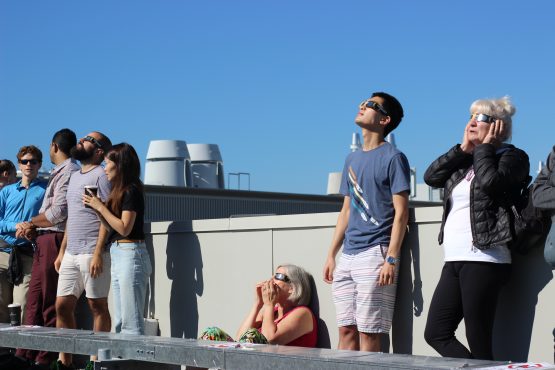Sunglasses, cereal boxes, and saltine crackers — all tools used to catch a glimpse of the solar eclipse that passed overhead at the University of Victoria on Monday, Aug. 21.
The Bob Wright Centre (BWC), home of UVic’s astronomy lab, and its surrounding lawns were filled with prospective astronomers looking for the first solar eclipse on the west coast in 38 years. UVic played the part of host, with several faculty members and recent graduates handing out special eclipse sunglasses and reciting information to any curious members of the public.

The event was a popular one. Photo by Cormac O’Brien, Editor-in-Chief
The eclipse proper began at 9:08 a.m., but BWC was crowded far before then. Karun Thanjavur, a UVic astronomer and co-ordinator of the event, explained that they were expecting about 300 or so people to show up to take part in UVic’s event. In reality, the crowd numbered somewhere close to one thousand.
Only 175 people made it onto the roof of BWC. There they had the choice of watching the sun directly using eclipse glasses, observing one of several video screens projecting the eclipse’s progression, or using a number of telescopes to watch the moon’s movement as it passed in front of the sun.
Victoria, B.C., was one of the best places to view the eclipse in Canada. People located on the island could see the moon cover ~90 per cent of the sun. Jordan King-Nyberg, a recent UVic astronomy and physics graduate, was on the roof to explain the science and significance of the eclipse.
“We’ve got some fancy equipment,” King-Nyberg said. “We’ve got telescopes and projectors that project the image of the sun onto a screen, and we have some solar glasses that became a really hot commodity on the island.”
Others used more creative ways to view the sun. There were plenty of pinhole cameras to be found — the filtering of the sun’s light through a small hole allows the image of the eclipse to be observed indirectly — but anything with a small hole worked. Some people used modified cereal boxes with eye-holes; some used saltine crackers.
With a far bigger crowd than expected, people on the roof and the lawn below shared one pair of solar glasses between groups of four or five. If anything, it added to the camaraderie of the day — the good feeling of witnessing a historical scientific event.

The moon cuts into the sun, viewed through the reflection of a telescope. Photo by Cormac O’Brien, Editor-in-Chief
The day was designed for the public, King-Nyberg explained, as scientists have been able to predict these eclipses with high degrees of precision for years.
“It’s more of just a cool event for the sky rather than a cool event for science,” he said. “That doesn’t make it any less exciting, though.”
A huge portion of the eclipse witnesses were children, with plenty of families setting up while keeping safe with solar glasses and sunscreen. Logan Francis, another recent astronomy graduate from UVic and volunteer for the day, said that catching astronomical events at an early age can help set up a career in the field.
“One of my memories from my childhood that made me interested in astronomy was seeing the Leonid Meteor Shower,” Francis said. “So [with] an eclipse event like this, I can definitely see getting someone interested in astronomy.”
King-Nyberg agreed.
“Especially when they’re at the perfect age to really appreciate it. [Children find] so much joy and wonder in the world,” he said.

Wesley gazes skywards. Photo by Cormac O’Brien, Editor-in-Chief
One such future astronomer was Wesley. Decked out in a space shirt (glasses safely secured) and handing out as much space information as you wanted, Wesley was excited for the eclipse.
He wasn’t sure if astronomy was the career choice just yet — ”Maybe,” was Wesley’s answer to the question — but with the next North American solar eclipse scheduled for 2024, he has time to think about it.








